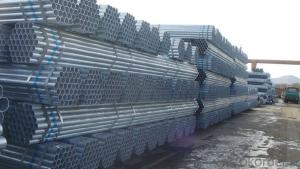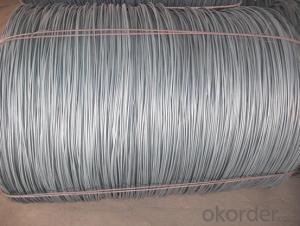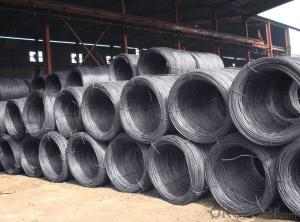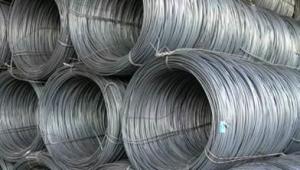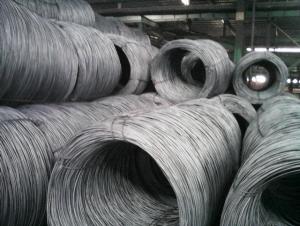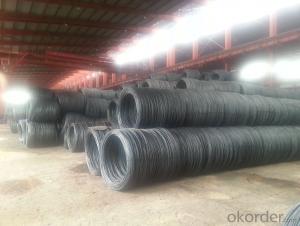Good quality 4mm galvanized mild steel wire
- Loading Port:
- Shanghai
- Payment Terms:
- TT OR LC
- Min Order Qty:
- 50 m.t.
- Supply Capability:
- 10000 m.t./month
OKorder Service Pledge
OKorder Financial Service
You Might Also Like
Quick Details
Steel Grade: 45#, 60#, 65#, 70#, 72A, 72B, 82B, 65Mn
Standard: AISI, ASTM, BS, DIN, GB, JIS
- Type: Galvanized
Application: Construction
Alloy Or Not: Non-alloy
- Diameter range: 0.02-16mm
Standard: AISI, ASTM, DIN, GB, JIS, SUS
Packaging & Delivery
| Packaging Details: | Coils Packing, spools packing, or according to the customers' requirements |
|---|---|
| Delivery Detail: | 10-20days after confirm the order |
Specifications
4mm galvanized mild steel wire
1.Diameter range:0.15-15mm
2.Main application:making spring,nail,mattress,wire
Good quality 4mm galvanized mild steel wire carbon steel wire
| Grade | 45#, 60#, 65#, 70#, 72A, 72B, 82B, 65Mn |
| Diameter | 0.15-15mm |
| Standard | AISI, ASTM, DIN, GB, JIS, SUS |
| Weight | According to the customers' requirements |
| Uses | To produce springs, steel wire ropes, brush and other uses |
| Packing | Coils Packing, spools packing, or according to the customers' requirements |
Terms:
1) Loading Port: Shanghai/Nantong
2) Delivery term: FOB,CFR, CIF
3) Delivery lead time: 10 working days after received deposit.
4) Payment term:30% by T/T as deposit., balance will be paid by T/T before loading,
5) Quality assurance: Mill Test Certificate is supplied with shipment, third Party Inspection is acceptable.
- Q: How is steel wire rod used in the manufacturing of wire for bicycle chains?
- Steel wire rod is a crucial component in the manufacturing of wire for bicycle chains. It serves as the primary raw material for producing the wire used in bicycle chains. The steel wire rod is usually made from carbon or alloy steel and has specific properties that make it ideal for this application. To manufacture wire for bicycle chains, the steel wire rod undergoes several processes. The first step involves drawing the wire rod through a series of dies to reduce its diameter and increase its length. This process is known as wire drawing and helps to improve the wire's strength, flexibility, and surface finish. After wire drawing, the wire is typically heat-treated to enhance its mechanical properties further. This heat treatment process, known as annealing, involves heating the wire to a specific temperature and then cooling it slowly. Annealing helps to increase the wire's hardness, toughness, and resistance to wear, making it more durable for use in bicycle chains. Once the wire is appropriately treated and processed, it is then formed into the desired shape for bicycle chains. This involves bending or cutting the wire into individual links, which are then interlocked to create the chain. The wire's strength and flexibility are crucial during this process, as it needs to withstand the tension and stress applied when the chain is in use. Overall, steel wire rod plays a vital role in the manufacturing of wire for bicycle chains. Its high strength, durability, and flexibility properties make it an ideal material for this application. The processes of wire drawing, heat treatment, and shaping ensure that the wire meets the necessary requirements for a reliable and long-lasting bicycle chain.
- Q: How are steel wire rods used in the production of electrical wires for conducting electricity?
- An essential element in producing electrical wires for conducting electricity is steel wire rods. These rods act as the central material around which the electrical wires are made. As a starting point, careful selection of steel wire rods is crucial due to their high tensile strength and conductivity properties. This guarantees that the resulting electrical wires are sturdy, long-lasting, and efficient in conducting electricity. The initial stage of the production process involves reducing the diameter of the steel wire rods by drawing them through a series of dies. This process, known as wire drawing, is utilized to achieve the desired thickness and shape of the electrical wire. By decreasing the diameter, the wire becomes more flexible and easier to handle during installation. Once the wire rods have been drawn to the necessary size, they are then coated with an insulating layer. This insulation is essential for preventing electrical leakage, short circuits, and safeguarding against external factors that may harm the wire. Commonly used insulation materials include PVC (polyvinyl chloride), XLPE (cross-linked polyethylene), or rubber. Following the insulation process, the wire rods undergo further processing to include any required additional features. For example, they may be twisted together to create multi-conductor cables, or copper strands may be added to enhance the wire's conductivity. These additional steps are performed based on the specific requirements of the electrical wire. Lastly, the wire rods are wound onto spools or coiled into reels, ready for use in various electrical applications. These applications can range from domestic wiring systems to industrial power distribution networks. In conclusion, steel wire rods play a vital role in the production of electrical wires. They act as the core material around which the wires are manufactured, ensuring strength, durability, and efficient conductivity. Through wire drawing, insulation, and other processing steps, the wire rods are transformed into high-quality electrical wires that are essential for conducting electricity safely and effectively.
- Q: What are the common production processes for carbon steel wire rod?
- The common production processes for carbon steel wire rod include melting and refining of the raw materials, such as iron ore and scrap metal, in a furnace to produce molten steel. This molten steel is then continuously cast into billets or blooms, which are further processed through hot rolling, cold drawing, and heat treatment to shape and strengthen the wire rod. Finally, the wire rod is coated or galvanized to enhance its corrosion resistance and surface finish.
- Q: How is steel wire rod used in the manufacturing of wire forms for ski lifts?
- Steel wire rod is used in the manufacturing of wire forms for ski lifts as it provides the necessary strength and durability required for supporting the weight of the ski lift cabins and passengers. The wire rod is typically shaped and formed into various components such as cables, ropes, and pulleys which are then assembled to create a secure and reliable system for transporting skiers up the slopes.
- Q: What are the common production processes for nobelium-coated steel wire rod?
- The common production processes for nobelium-coated steel wire rod include wire drawing, coating application, drying, and annealing.
- Q: What are the main challenges in recycling steel wire rod?
- Recycling steel wire rod presents several primary challenges. To begin with, the collection and sorting of steel wire rod pose a major obstacle. Steel wire rod exists in various forms and sizes, making it difficult to separate from other materials during recycling. Advanced sorting technologies and efficient collection systems are necessary to ensure that only steel wire rod is recycled and other materials are appropriately sorted. Another challenge arises from the presence of contaminants in steel wire rod. Coatings like zinc or other metals frequently accompany steel wire rod and must be removed before recycling. These coatings can impede the quality of the recycled steel and may necessitate additional processing steps to guarantee the purity of the final product. Additionally, recycling steel wire rod is energy-intensive. The melting process employed in recycling requires high temperatures and consumes a substantial amount of energy. This presents challenges in terms of both cost and environmental impact, as it contributes to greenhouse gas emissions and demands significant energy resources. Moreover, the transportation and logistics involved in recycling steel wire rod can be problematic. Steel wire rod is often bulky and heavy, leading to increased transportation costs and necessitating specialized equipment for handling and processing. The logistics of collecting, transporting, and storing steel wire rod for recycling can be intricate and require efficient coordination to ensure a smooth recycling process. Lastly, fluctuations in market demand for recycled steel wire rod can create challenges for recycling facilities. The demand for steel wire rod is influenced by economic conditions, construction activities, and infrastructure development. During periods of low market demand, recycling facilities may struggle to find buyers for their recycled steel wire rod, impacting the profitability and viability of the recycling process. In conclusion, the primary challenges in recycling steel wire rod encompass collection and sorting, removal of contaminants, energy consumption, transportation and logistics, and market demand fluctuations. Addressing these challenges necessitates technological advancements, efficient processes, and a strong market demand for recycled steel wire rod.
- Q: How is steel wire rod used in the manufacturing of fencing?
- Steel wire rod is commonly used in the manufacturing of fencing as it provides strength and durability to the fencing structure. It is often used to make the vertical wires or pickets of the fence, which are then attached to horizontal wires or rails to form the fence panels. The steel wire rod is typically galvanized or coated to prevent corrosion and increase its lifespan. This allows the fencing to withstand harsh weather conditions and provide security and containment for various applications, such as residential, commercial, or agricultural purposes.
- Q: How is steel wire rod used in the manufacturing of wire for automotive seatbelts?
- Steel wire rod is used in the manufacturing of wire for automotive seatbelts as it serves as the primary raw material. The steel wire rod is first drawn through a series of dies to reduce its diameter and increase its length, resulting in a high-strength wire. This wire is then further processed to meet the specific requirements of seatbelt manufacturing, such as heat treatment for optimal strength and ductility. The end result is a durable and reliable wire that can withstand the immense forces experienced during a car accident, ensuring the safety of passengers by effectively restraining them in their seats.
- Q: What are the main factors influencing the choice of steel wire rod order confirmation process?
- The selection of the order confirmation process for steel wire rod is influenced by various factors related to the business and industry. However, there are certain common factors that typically affect this decision: 1. Customer preferences: The specific requirements and preferences of customers are crucial in determining the order confirmation process. Some customers may prefer a streamlined and automated process, while others may require a personalized and manual approach. 2. Complexity of orders: The complexity of the steel wire rod order can also impact the choice of confirmation process. If the order involves multiple specifications, customizations, or special requirements, a more detailed and thorough confirmation process may be necessary for accuracy. 3. Order volume: The volume of orders received by the business can also influence the choice of confirmation process. For smaller order volumes, a simpler and less time-consuming process may suffice. Conversely, larger order volumes may require a more efficient and automated confirmation process to handle the increased workload. 4. Time sensitivity: The urgency or time sensitivity of the order is another factor to consider. If the order needs quick confirmation to meet tight deadlines, a streamlined and expedited confirmation process may be necessary. 5. Internal capabilities: The internal capabilities and resources of the business also play a role in determining the order confirmation process. If the business has advanced technology and systems in place, it may be able to implement a more automated and efficient confirmation process. Conversely, if resources are limited, a more manual and time-consuming process may be the only viable option. 6. Industry standards and regulations: Certain industries have specific standards and regulations that dictate the order confirmation process. Compliance with these standards is crucial, and the choice of confirmation process may need to align with industry requirements. 7. Risk management: The level of risk associated with the order can influence the choice of confirmation process. If there are potential risks or uncertainties involved, a more comprehensive and detailed confirmation process may be necessary to minimize errors or discrepancies. In conclusion, a careful evaluation of these factors is necessary to ensure an efficient, accurate, and customer-centric order processing in the steel wire rod industry.
- Q: How is steel wire rod used in the production of tire reinforcement materials for vehicles?
- Steel wire rod is used in the production of tire reinforcement materials for vehicles as it provides high tensile strength, durability, and resistance to deformation. The steel wire rod is typically processed into thin filaments or cords which are then embedded in the tire's rubber compound to enhance its structural integrity, improve grip, and increase overall performance. These steel reinforcements help the tire withstand the forces exerted during acceleration, braking, and cornering, ensuring a safer and more reliable driving experience.
Send your message to us
Good quality 4mm galvanized mild steel wire
- Loading Port:
- Shanghai
- Payment Terms:
- TT OR LC
- Min Order Qty:
- 50 m.t.
- Supply Capability:
- 10000 m.t./month
OKorder Service Pledge
OKorder Financial Service
Similar products
Hot products
Hot Searches
Related keywords












